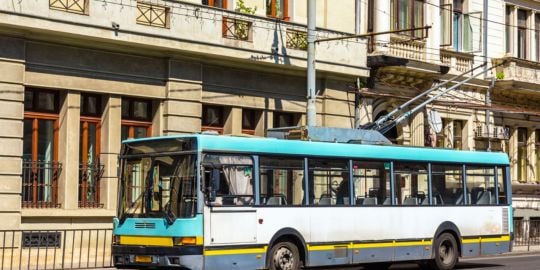Public transportation in Bucharest
With a population of over 2 million people, it is easy to understand why Bucharest has such a dense public transportation network. In addition to that, keep in mind that the public transportation service is often preferred to personal cars because of traffic, which can be pretty hectic during the rush hours. However, quite often this hectic traffic makes the surface public transportation to be rather unreliable in terms of schedule and duration.
The surface public transportation service is provided by the Autonomic Administration of Transportation Bucharest (Regia Autonoma de Transport Bucuresti), or just RATB. The functioning hours for RATB is 05:00-24:00. This service includes: trams, buses and trolleybuses. A link to the RATB website and to the network maps can be found here: http://www.ratb.ro/index.php?page=harta.
The fee for the public transportation can be paid in two ways: tickets or electronic cards. The tickets have to be perforated in machines placed in the vehicles. The electronic cards must be validated by waving them in front of the orange machines placed on the pools, near the seats Both the tickets or the cards have to be purchased before you get on the bus or any other public transportation vehicle, and not after, because the driver or any other person from the bus is not empowered to sell them. From time to time, a ticket inspector will get on the vehicle and will ask for your card or ticket. If you do not own one or it is not a valid one, the ticket inspector will ask you for your ID and he will give you a fine of 50 RON (about 12 EUR or 16 USD). If you do not have your ID or it is not valid, he will take you to the police station and there he will give you a fine of 100 RON (about 24 EUR or 32 USD).
These tickets and cards can be found at 240 specials kiosks, near tram/bus/trolley stations, that have the RATB sign written. You can buy a card for two tickets, for which you will pay 4.2 RON (1 EUR or 1,4 USD), ten tickets, 14.6 RON or you can buy a pass for one day, one week, two weeks or one month, and you can travel by any surface public vehicle for an unlimited number of times, during the specified period. A pass for one day costs 8 RON, for one week, 15 RON, for two weeks, 25 RON and for a month, 50 RON.
There are 2.800 bus, tram and trolley stations, spread all over the Bucharest. There are in total 25 trams lines, 116 bus lines, 20 trolleys lines and 2 express lines.
RATB offers also two special lines, called express, which take you from Unirii Square to The International Airport Henri Coanda (line number 783), or from Fluviului Street to The International Airport Henri Coanda (line number 780). You have to buy special tickets for these, from any station or from the airport, and they will cost you 7 RON for two tickets, 27 RON for ten tickets and 80 RON for a one month pass.
Another special line is the Students' Line number 601, which connects the major university areas, such as Regie Dormitory or University Square.
The fourth public transportation service that RATB offers is represented by the Maxi-taxi. These vehicles can transport up to 25 people and they can have different fees, depending on the distance that you need transportation for. Their routes usually coincide to the others' vehicles offered by RATB, but some of them actually extend to the outside of Bucharest. To get on a maxi-taxi, you have to wave the driver and he will stop. You don't have to buy a ticket or a card in advance, you just tell the driver where you want to go and he will tell you how much it costs you. Unlike trams or any other public transportation vehicles, the maxi-taxis stop wherever you tell the driver to stop on the route.
If you want to go from Bucharest to the nearby regions outside the city, you can use special buses offered by RATB. There are two kinds of tickets for these buses: tickets for regions within 20 km, and for regions beyond 20 km. For the first type, the price is 1.5 RON per ticket, and for the second one, 2.5 RON. You can also buy a pass for one month, for only one of these lines, which will cost you 35 RON, for two lines, 50 RON, or for all the lines, 65 RON.
The underground public transportation service is offered by METROREX. The underground transportation network is 66.95 km long; it has 4 main lines and 49 stations, with an average distance between stations of 1.5 km. The first line leaves from Republica and goes to Dristor 2, connecting stations such as Eroilor or Gara de Nord 1, the second line leaves from Pipera and goes to Berceni, connecting stations such as Piata Victoriei and Eroii Revolutiei, the third line leaves from Preciziei and goes to Anghel Saligny, connecting stations such as Eroilor or Nicolae Grigorescu 2 and the fourth line leaves from Gara de Nord 2 and goes to 1 Mai. A link to the METROREX website and to the network map can be found here: http://www.metrorex.ro/harta.html.
You can buy a card with two tickets, which costs 2.5 RON, with ten tickets, which costs 8 RON, a pass for one day, which costs 5 RON or a pass for one month, which costs 25 RON. With these cards you can travel with any line you want and you can change the line without paying for another ticket, but if you use a ticket, and not a pass, you should know that it is only valid before you get out from the subway area. If you get out and then you want to travel by metro again, unless you have a valid pass, you must use another ticket or buy another card. You can buy a card or a pass from any metro station, from special kiosks where there is written Casa. You should pass the card through the machines placed in front of the steel bars, with the red arrow down and with the printed side facing you. After you introduce the card in the machine, it will be automatically validated and it will be easily pulled out. You have to pull it out completely and take it with you and just push the steel bars to pass. If you find difficulties during this process, you will find some METROREX employees wearing black and green uniforms, which are willing to help you. Alternatively, one can use the same electronic card that is used for the buses and trams.
After you get through the bars, you should read the maps placed above the rail train to see on what side your train will arrive. If you are in one of the stations where several lines meet, such as Nicolae Grigorescu, Dristor, Piata Unirii, Eroilor, Basarab, Gara de Nord or Piata Victoriei, you will find guiding arrows to get to the platform where the train with the direction you want comes. After you get on the train, you should pay attention to the voice announcing what station comes next and on what side will the doors open. Unfortunately this service is only provided in Romanian, so it may take some time to foreign travellers to get used to it. Also, if you feel that you are lost or you took the wrong train, you will find some maps drown on the train's walls. You will also find METROREX employees, wearing the same black and green uniforms, in case you are attacked or you find yourself in danger. When you want to exit to surface, you must pass through the steel bars that do not have any machine placed upon them.
The underground transportation service can be a very useful manner of travelling in the city, given the fact that it can save you a lot of time. Unfortunately the underground network is not sufficiently developed and there are many areas where one cannot go this way.
Author: Business Support Services for Foreigners in Romania (www.bssf.ro)









